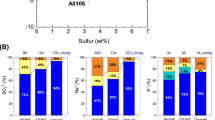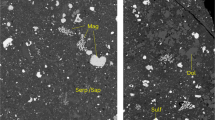Abstract
Stable and radiogenic isotope compositions are commonly used to identify the solution from which minerals such as sulphate, carbonate and silicate were crystallized. Both the sources and the ages of evaporite deposits can be determined by measuring radioactive 36Cl concentrations using new developments in accelerator mass spectrometry. Halite crystals found in saline sediments, which could not be measured by isotope techniques until this method was developed, are usually assumed to have precipitated from the lake water during former dry periods. In the case of the Dead Sea we tested this assumption by comparing the abundance of 36Cl isotopes in a shallowly buried halite layer with that in the overlying water. We found that the 36Cl/Cl ratio is significantly lower in the halite, which indicates that the salt did not crystallize from this water but from a solution originating from the Tertiary diapir underneath the sea or that the salt represents the top of the Mt Sdom formation diapir.
This is a preview of subscription content, access via your institution
Access options
Subscribe to this journal
Receive 51 print issues and online access
$199.00 per year
only $3.90 per issue
Buy this article
- Purchase on Springer Link
- Instant access to full article PDF
Prices may be subject to local taxes which are calculated during checkout
Similar content being viewed by others
References
Kaufman, R., Long, A., Bentley, H. & Davis, S. Nature 309, 50–52 (1984).
Phillips, F. M., Smith, G. I., Bentley, H. W., Elmore, D. & Grove, H. E. Science 222, 925–927 (1983).
Paul, M. et al. Nature (submitted).
Bentley, H. W., Phillips, F. M. & Davis, S. N. in Handbook of Environmental Isotope Geochemistry Vol. 2 (eds Fritz, P. & Fontes, J. C.) (Elsevier, Amsterdam, in the press).
Volcani, B. E. in The Microorganisms of the Dead Sea, 71–85 (Sieff Research Institute, Rehovot, 1944).
Neev, P. & Emery, K. O. Bull. geol. Surv. Israel 41 (1967).
Beyth, M. in Developments in Sedimentology (ed. Nissenbaum, A.) 155–164 (Elsevier, Amsterdam, 1980).
Levy, Y. Rep. geol. Surv. Israel GSI/48/84 (1984).
Fink, R. et al. Nucl. Instrum. Meth. Phys. Res. 135, 123–125 (1984).
Neev, D. & Hall, F. K. Sed. Geol. 25, 209–238 (1979).
Bentor, Y. K. Geochim. cosmochim. Acta 25, 230–260 (1961).
Bloch, M. R. & Picard, L. Z. dt. Geol Ges. Sonderh. Hydrogeol. Chem., 119–128 (1970).
Author information
Authors and Affiliations
Rights and permissions
About this article
Cite this article
Magaritz, M., Kaufman, A., Levy, Y. et al. 36C1 in a halite layer from the bottom of the Dead Sea. Nature 320, 256–257 (1986). https://doi.org/10.1038/320256a0
Received:
Accepted:
Issue Date:
DOI: https://doi.org/10.1038/320256a0
This article is cited by
-
Environmental radiochemistry and radioactivity
Journal of Radioanalytical and Nuclear Chemistry Articles (1987)
Comments
By submitting a comment you agree to abide by our Terms and Community Guidelines. If you find something abusive or that does not comply with our terms or guidelines please flag it as inappropriate.



